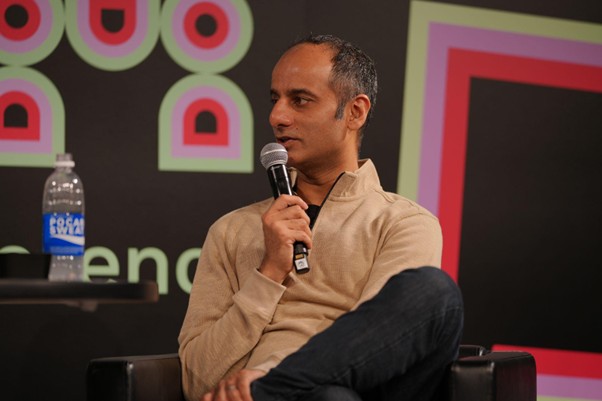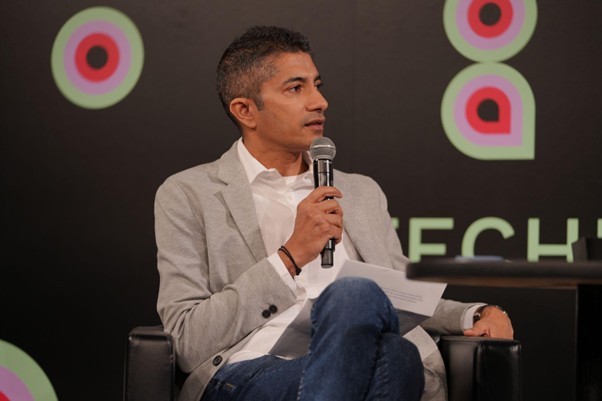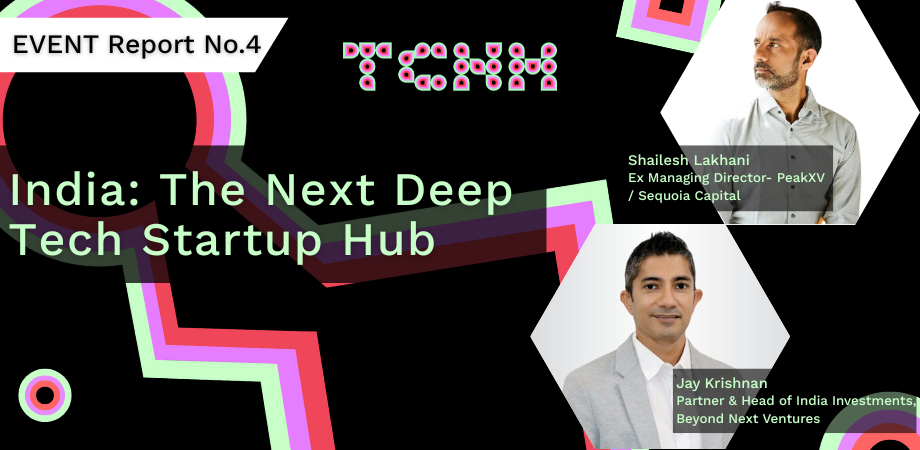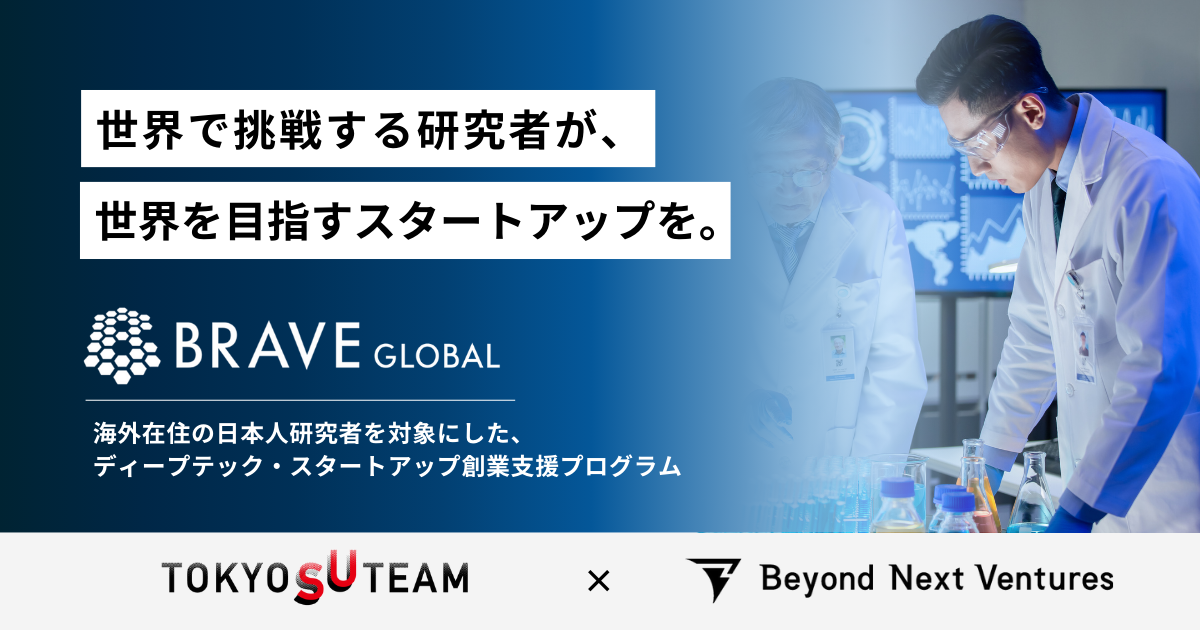Beyond Next Ventures co-hosted the TECHNIUM Global Conference, Japan’s first international conference dedicated to deep-tech on May 7-8. It brought together leading players driving Japan’s deep-tech startup ecosystem and featured a wide range of insightful sessions.
As this conference was invitation-only and received a great deal of attention, we are excited to share some highlights from the sessions for those who were unable to attend in person.
In this event report, we will introduce a session titled “India: The World’s Next Deep Tech Darling Startup Destination”, which was held during the conference.
Session Title:
India: The World’s Next Deep Tech Darling Startup Destination
-Powered by Beyond Next Ventures
Moderator:
Jay Krishnan, Partner & Head of India Investments, Beyond Next Ventures
Speakers:
Shailesh Lakhani, Ex Managing Director- PeakXV / Sequoia Capital
Transition Of Start-up Ecosystem In India
Jay Krishnan opened the session with insights on the evolution of India’s start-up ecosystem over the last two decades, He said that, “In 2010, India had a capital velocity of less than a billion dollars, one or two IPOs, and a handful of startups and unicorns.”
Fast forward to 2025, capital velocity is now at $15- 20B, along with 110+ unicorns. “The country has the world’s third largest startup ecosystem measured by many parameters. India has come a long, long way,” Jay said.
To delve deeper into the topic, Jay asked the guest speaker Shailesh Lakhani why he moved to India in 2010 when the Asian nation wasn’t really a startup destination.

Shailesh answered that it was solely due to the foreseeable opportunities. “It was always straightforward to think that India would be a large consumer market and hundreds of millions of people would join the middle class,” he remarked.
He further said that India wasn’t digitally connected in his early days. “It’s really the advent of 4G Internet as well as the rising disposable income that led to the development of the ecosystem,” while also mentioning the abundance of software engineers as a contributing factor.
Shailesh described his earlier journey as a venture capitalist as “very slow” yet interesting for he had the “access to all the leading companies early on,” giving an example of e-commerce company Flipkart. But as the time passed by, the industry became much faster, resulting in limited interactions with the founders.
What was fun was “seeing how people develop, change and grow, and are capable of way more than when they start. And that’s really the beauty of business,” he said with a hint of nostalgia in his voice.
Reflecting on his own experience of running a hardware startup in India 10 years ago, Jay said “what has always existed back then and continues to exist in India is the talent. What has changed is the evolution of a deeptech ecosystem,” where design can very quickly be taken to prototyping. The venture mindset has also changed where the friction to hardware has significantly decreased.
Indian Govt. Support for Deep-Tech, Much Ground Yet To Cover
Shailesh said the Indian government has recently been quite keen in rearing the country’s deep-tech industry and provided manufacturing grants for the same. The authorities also provided some 3000 GPUs to startups to train models and announced the launch of five new Indian Institutes of Technology or IITs.

“The government is looking to enhance the bandwidth so that there’s a big push towards a much more advanced startup system,” he remarked.
He further shared how an Indian minister had recently reprimanded venture capitalists for insufficient effort toward building deep-tech companies, while an overwhelming amount of attention and resources currently being directed toward consumer-focused ventures like food delivery services.
Shailesh, however, pointed out that Indian infrastructure remains poor and there is significant room for improvement.
More Startups Going Public in India
Jay next talked about the changing face of India’s IPO market. Describing 2024 as a “fantastic” year that “saw over 250 IPOs,” he sought Shailesh’s opinion on whether or not the previous years “was an outlier?”
Shailesh agreed that the “water was very warm for many start-ups.” Calling India a vibrant capital market, he said a company with 50 to 100 million in revenue and reasonable growth rate can easily go public in India, the country where the M&A market is also developing reasonably well.
He underscored this transition as the greatest change observed over the last decade as it was often a challenge to have exits in India. “And that’s obviously very important for venture capital. You have to complete the cycle and put the money back.”
Indo-Japan Collaboration
The floor was soon opened to questions from the audience, where a participant asked if a Flipkart could happen in Japan and about the similarities or dissimilarities you see between India and Japan.
Shailesh answered that venture capital is a really local business and one needs to understand what is great in a particular market. “What I gather is that Japan has seen a relatively modest level of investor capital over the past few years. While there’s significant potential in the market, there’s still some way to go before it fully realizes its vibrancy.”
As for possibilities for Japanese companies willing to venture into India, Shailesh said it’s a big endeavor to localize a product in India, but factors like duties, incentives and tariffs can make it worth it. Giving the achievement of Suzuki, he said the Japanese company has successfully reaped dividends over a long period of time.
India “is a market that requires a lot of patience” and a company would need to change many aspects of its product, localize it to be able to suit the local market, and redevelop their supply chain. To illustrate, he talked about Apple that decided to move its entire iPhone production to India, saying the ecosystem of suppliers and people who understand how to create complicated products makes the process easier and spurs a faster growth.
When another audience requested the speaker to elaborate on the opportunity for an alliance between Japan and India, Shailesh said there are many areas where two countries and the governments could collaborate.
He added that most advanced research that comes up in Japan should be productized in India, which in turn will open doors for other markets from India for Japanese companies. He again highlighted the alliance between Suzuki and Maruti that made the exports of their vehicles to other developing markets possible, and also gave an example of Honda.

Jay concluded the session saying “I don’t think that there has been a better opportunity for India and Japan to collaborate.”
The TECHNIUM Global Conference attracted around 2,000 participants over two days. The event featured over 500 showcases of cutting-edge technologies and research seeds, along with themed sessions on key fields such as healthcare, drug discovery, biotech, climate tech, space, and AI.
The conference also provided numerous practical networking opportunities, bringing together researchers, startups, investors, and corporations. Over 1,000 business meetings took place at the dedicated matching booths, contributing to the vibrant energy of the event.
TECHNIUM Global Conference official website: https://tcnm-gc.com/#EN










